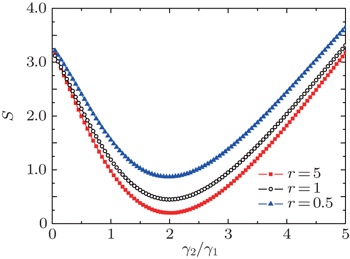† Corresponding author. E-mail:
Project supported by the National Natural Science Foundation of China (Grant No. 91430109), the Specialized Research Fund for the Doctoral Program of Higher Education of China (Grant No. 20111401110004), and the Natural Science Foundation of Shanxi Province, China (Grant No. 2014011005-3).
We analyze the entanglement characteristics of three harmonic modes, which are the output fields from three cavities with an input tripartite entangled state at fundamental frequency. The entanglement properties of the input beams can be maintained after their frequencies have been up-converted by the process of second harmonic generation. We have calculated the parametric dependences of the correlation spectrum on the initial squeezing factor, the pump power, the transmission coefficient, and the normalized analysis frequency of cavity. The numerical results provide references to choose proper experimental parameters for designing the experiment. The frequency conversion of the multipartite entangled state can also be applied to a quantum communication network.
Quantum frequency conversion (QFC) has been proposed to connect telecommunication wavelength light (carrier) with atomic transitions (quantum memories)[1,2] and improvement of optical detection,[3] by using the nonlinear effect in nonlinear media χ(2) and χ(3). It can be used to change the frequency of a quantum state to a desired one.[4,5] It is proved that the properties of quantum states of light can be maintained during QFC, including non-classical correlation,[6] entanglement,[7] non-classical photon statistics,[8–11] photon coherence,[12,13] and orbital angular momentum.[14] Recently, the successful experiments of spectral compression of single photons,[15] infrared or mid-infrared up-conversion imaging,[16,17] and quantum up-conversion of squeezed states[18,19] has aroused interest in exploring more applications of QFC. A direct quantum interface between photonic qubits of widely different wavelengths was demonstrated in Ref. [7]. In their work, the energy–time entanglement of a photon at 1310 nm with a photon at 1550 nm was transferred to that of another photon at a wavelength of 710 nm via sum-frequency generation (SFG). It is verified that the entanglement is unaffected, though one of the two entangled photons is transferred by an up-conversion process. As 710-nm wavelength is close to alkaline atomic transition and the transmission wavelengths for photons in optical fibers are 1310 nm and 1550 nm,[20,21] the converted entanglement can be used for quantum networks based on atoms and photons.[22]
On the other hand, it is known that when three continuous variable (CV) single-mode squeezed states input on two beam splitters, a tripartite CV entangled state is yielded. In Ref. [23], the squeezing direction of mode 1 is Y, the other modes are squeezed in X as shown in Fig.
The scheme of frequency doubling process is depicted in Fig. 





 | Fig. 2. Scheme of physical system for frequency doubling using cavity.   |
The input–output relations of the amplitude quadrature components 



It is found that it is easy for the variances to be below the shot noise limit (SNL) and the perfect entanglement can be obtained with infinite squeezing (r1 = r2 → ∞) in single-mode squeezed states.
We will discuss the process of SHG and analyze the preserved tripartite entanglement among the output fields 


Under the assumption of perfect phase matching and zero detuning, the Hamiltonian describing the interaction in the cavity can be written as



Assuming that nonlinear coefficient κ and loss coefficient γ are the same for all cavities, the quantum Langevin equations of motion for the cavity modes can be expressed as




In the symmetric case, we set the steady-state amplitudes of the fundamental modes α1 = α2 = α3 = α and 





The linearized equations of motion for quadrature-phase amplitude may be written in a matrix form by setting the following relations âj = αj + δ âj, 



According to the boundary condition of the coupling mirrors 



According to Eq. (





Because the variances of the relative amplitude quadratures and total phase quadratures of the input tripartite entanglement are identical and we have assumed the parameters of the three cavities to be the same, the correlation spectra S1 = S2 = S3 = S. The dependences of S on the normalized analysis frequency Ω = ω τ/γ1 under different squeezed factor are shown in Fig.
We propose a scheme to preserve the tripartite entanglement based on the process of SHG in three cavities, and it can be realized when the cavity operates far below the threshold. The dependences of the correlation spectrum on the parameters of cavity, the analysis frequency, and the initial squeezing are discussed. The entangled state conversion between different frequencies can be used to connect the atom with light in a quantum communication network, and the experimental scheme can be realized with the matured entanglement technology.
| 1 | |
| 2 | |
| 3 | |
| 4 | |
| 5 | |
| 6 | |
| 7 | |
| 8 | |
| 9 | |
| 10 | |
| 11 | |
| 12 | |
| 13 | |
| 14 | |
| 15 | |
| 16 | |
| 17 | |
| 18 | |
| 19 | |
| 20 | |
| 21 | |
| 22 | |
| 23 | |
| 24 | |
| 25 | |
| 26 |






